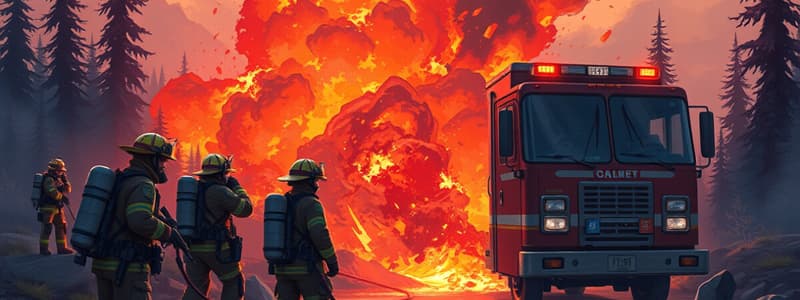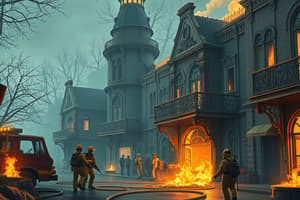Podcast
Questions and Answers
What principle governs the decision to risk lives during fireground operations?
What principle governs the decision to risk lives during fireground operations?
- The availability of resources on-site
- The likelihood of extinguishing the fire
- The historical data of similar incidents
- The application of the Risk Management Plan (correct)
Under what condition might the Incident Commander decide to change the fireground strategy?
Under what condition might the Incident Commander decide to change the fireground strategy?
- If additional personnel arrive on the scene
- When a new type of fire equipment is deployed
- When the weather conditions deteriorate
- If certain benchmarks, such as ALL CLEAR, are obtained (correct)
What is the primary factor that influences the level of risk the Incident Commander is willing to accept?
What is the primary factor that influences the level of risk the Incident Commander is willing to accept?
- The potential for extinguishing the fire
- The ability to access additional resources
- The possibility of saving lost lives (correct)
- The status of the property involved
In a fire incident, which fireground factor is most important when assessing a life hazard?
In a fire incident, which fireground factor is most important when assessing a life hazard?
What does the term 'Offensive strategy' imply in fireground operations?
What does the term 'Offensive strategy' imply in fireground operations?
Study Notes
Fireground Operations Strategy
- Structural fireground operations are categorized into two main strategies: Offensive and Defensive.
- The Incident Commander determines and declares the fireground strategy for all structure fire incidents.
- Continuous reevaluation of the fireground strategy occurs, influenced by size-up assessments and risk management principles.
Risk Management Plan
- The Fireground strategy is aligned with a Risk Management Plan, which dictates the level of risk taken during operations.
- Three key rules guide the risk-taking approach:
- Significant risks are taken to save lives that are deemed SAVABLE.
- Limited risks are taken to protect SAVABLE property.
- No risks are justified for lives or property that are considered already lost.
Decision-Making Factors
- The Incident Command evaluates various factors to select the appropriate strategy based on current conditions.
- Strategies may change depending on evolving scenarios or the achievement of specific benchmarks, such as an "ALL CLEAR" status.
Key Fireground Factors
- Building: Structural integrity and fire behavior characteristics.
- Fire & Smoke: Analysis of fire spread, heat, and smoke conditions.
- Life Hazard: Assessment of potential risks to civilian or firefighter lives.
- Occupancy: Understanding of the building’s purpose and occupancy patterns.
- Arrangement: Layout of the structure and access points.
- Resources: Availability and reliability of firefighting teams and equipment.
- Other Factors: Any additional influencing elements that could impact strategy decision-making.
Studying That Suits You
Use AI to generate personalized quizzes and flashcards to suit your learning preferences.
Description
Test your knowledge on the fundamental strategies of fireground operations. This quiz focuses on understanding Offensive and Defensive strategies as declared by the Incident Commander. Learn how risk management plays a crucial role in determining these strategies for structure fire incidents.




